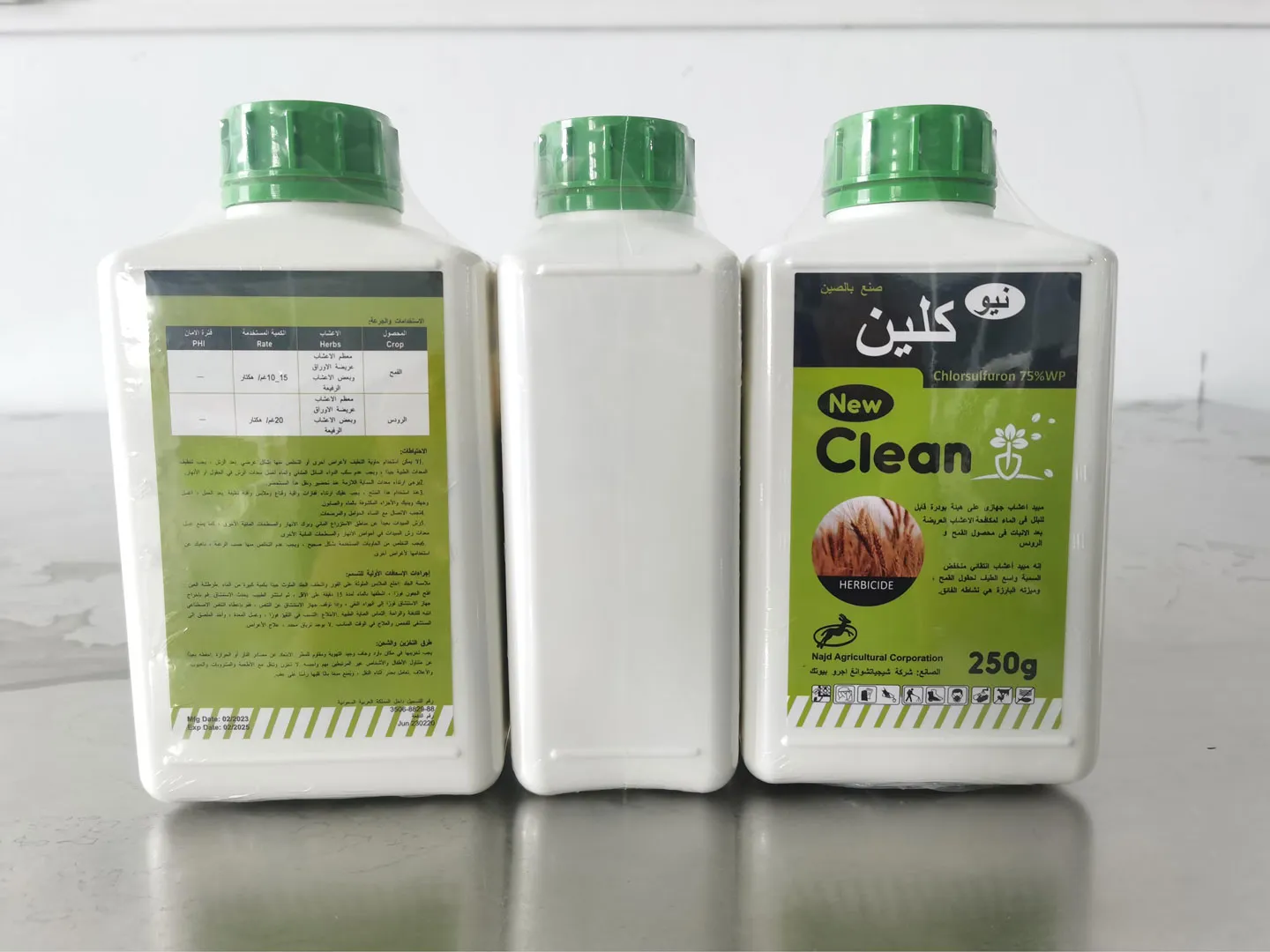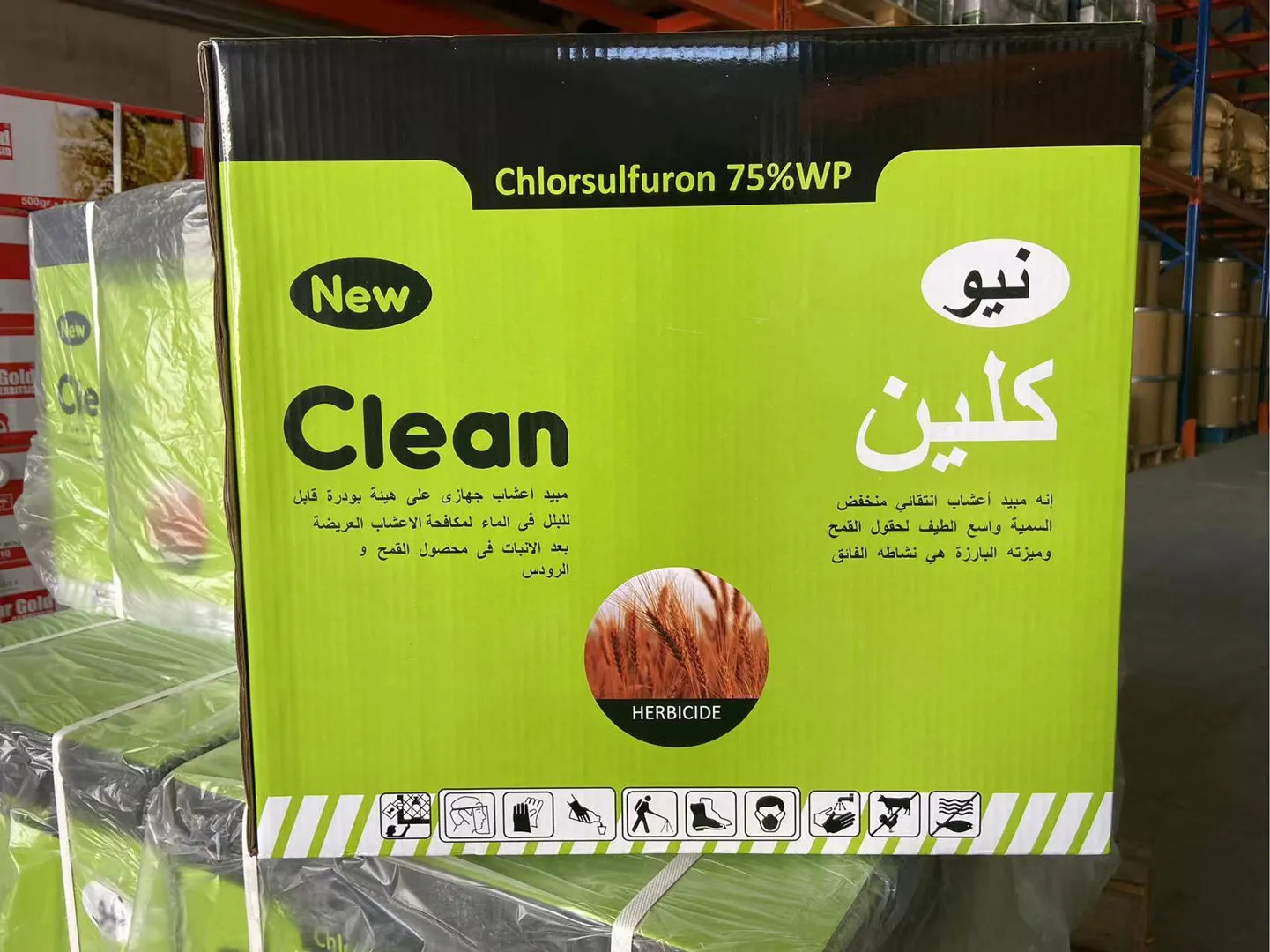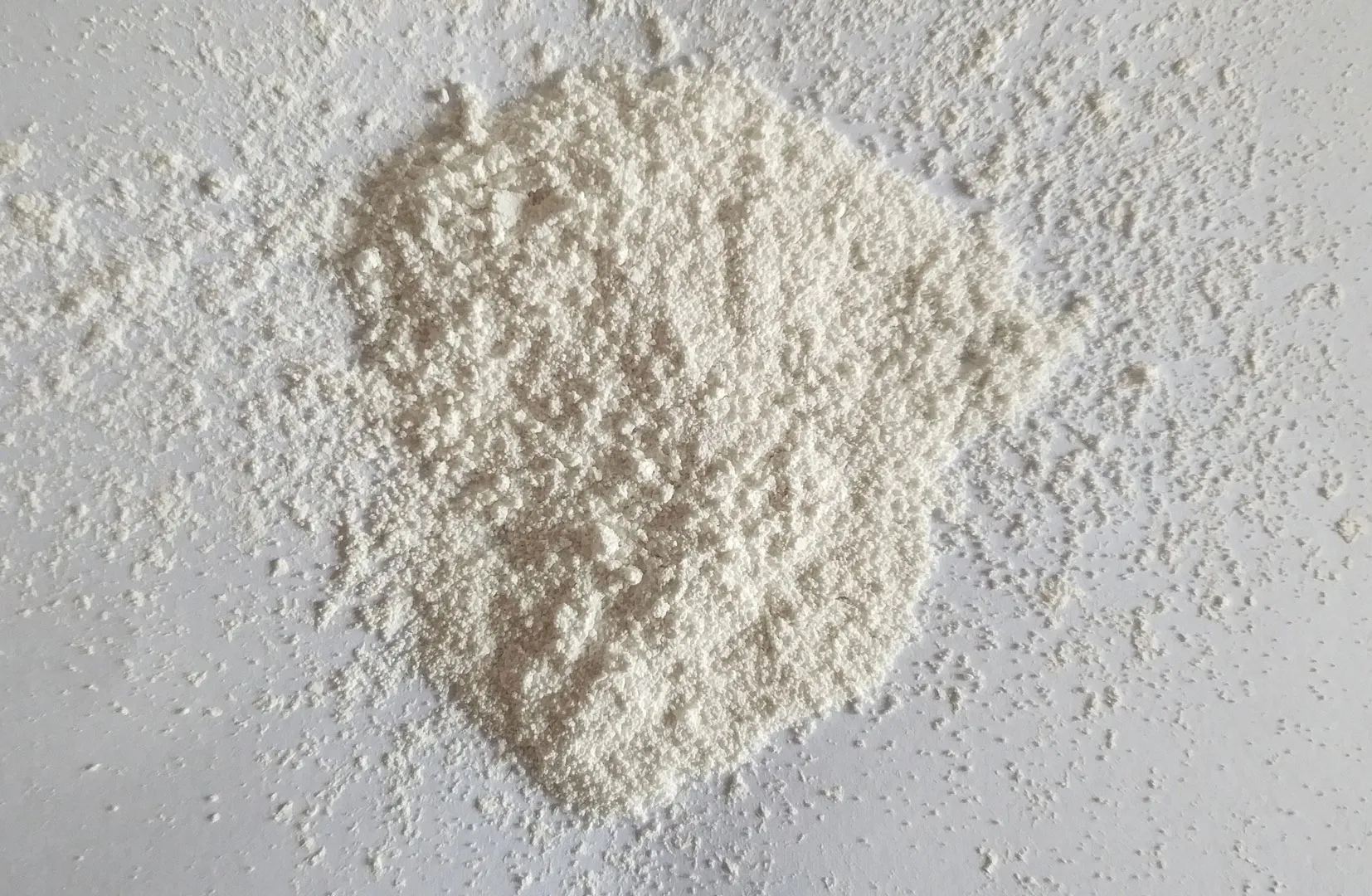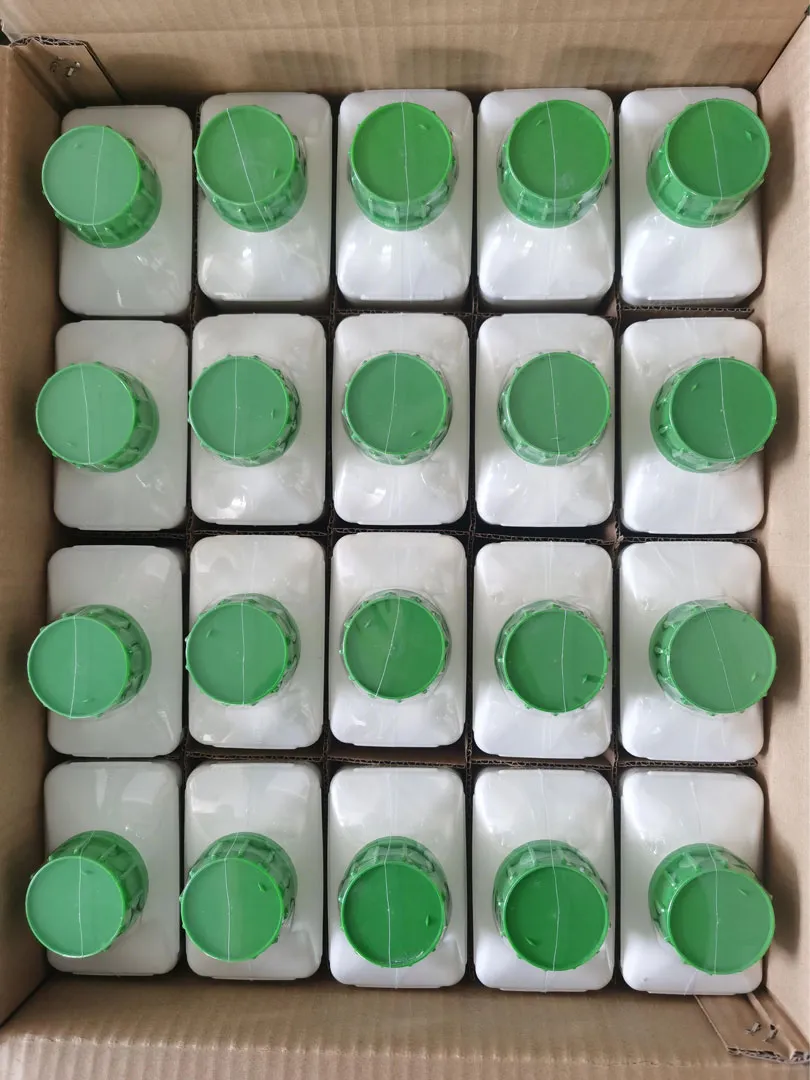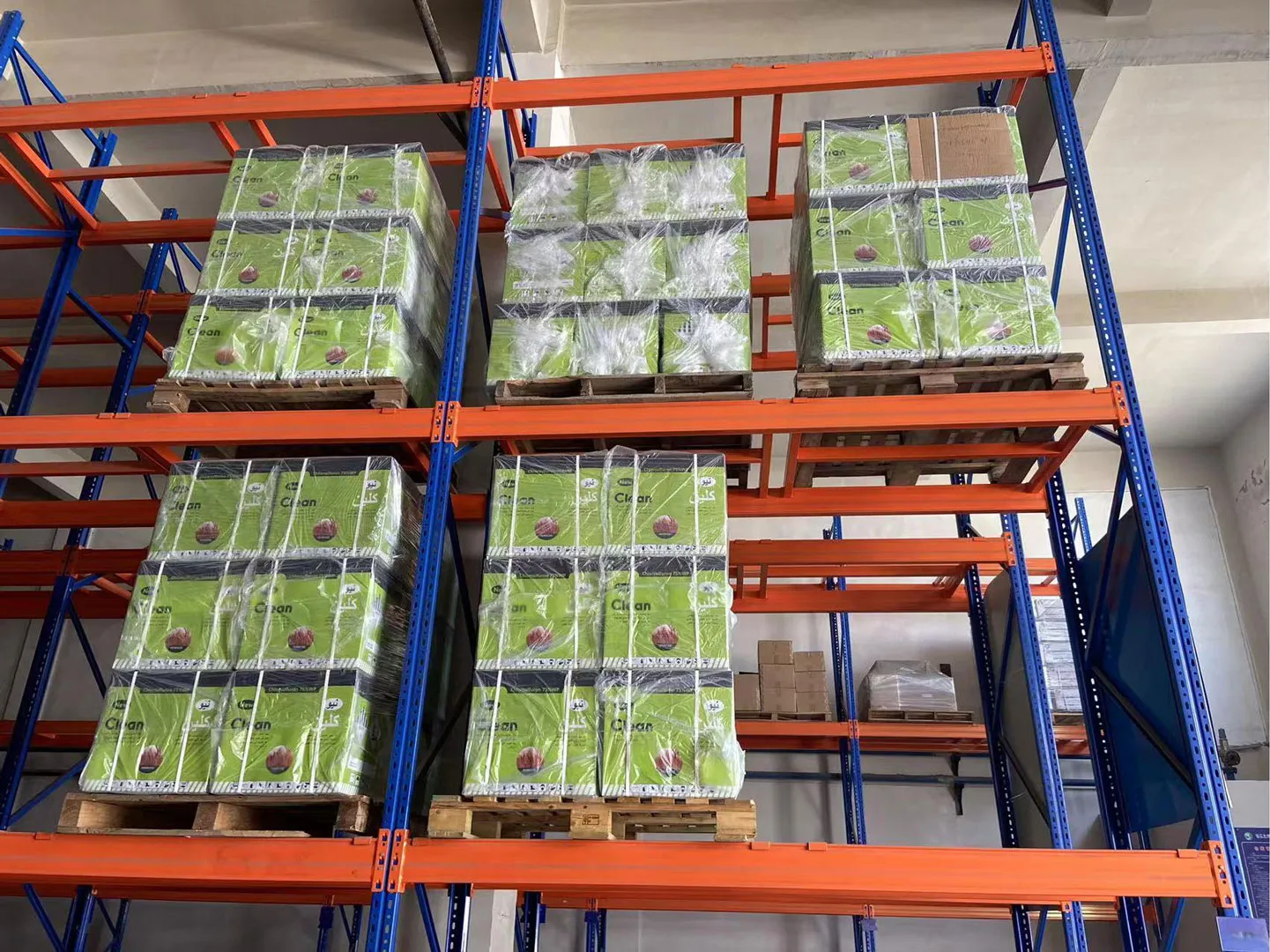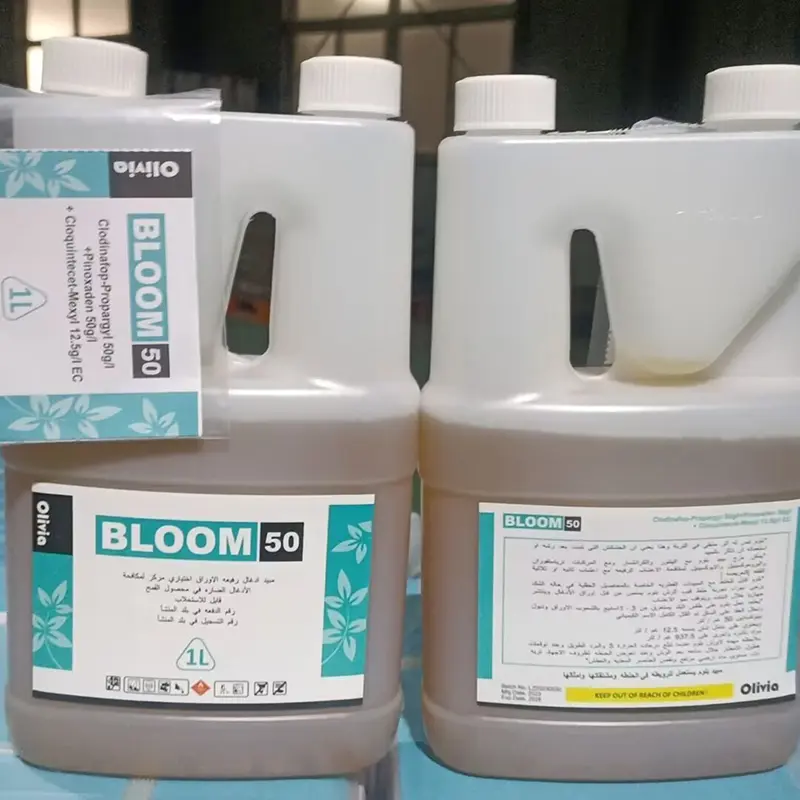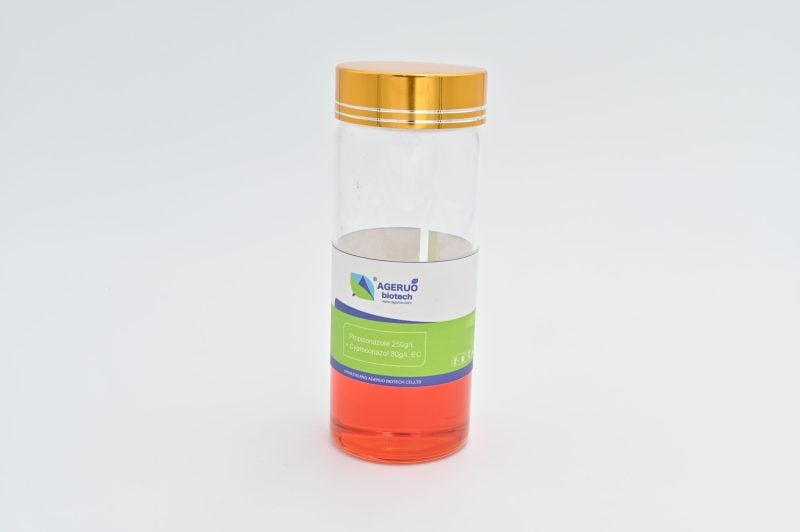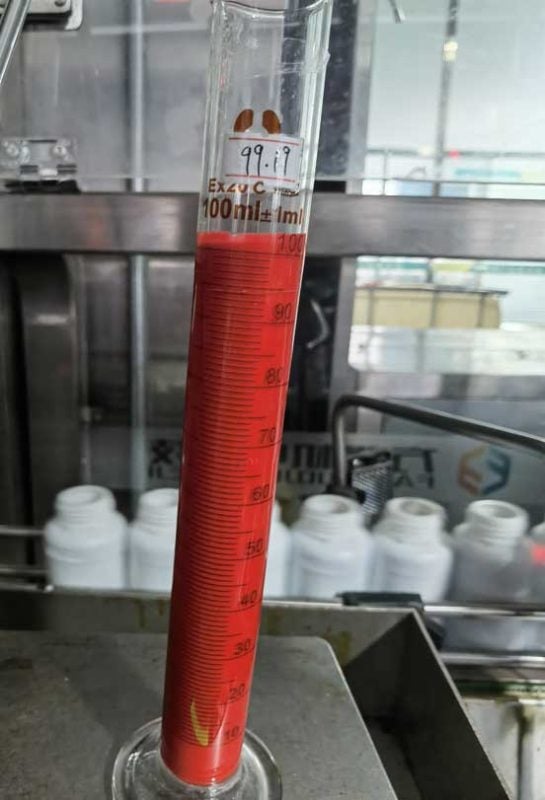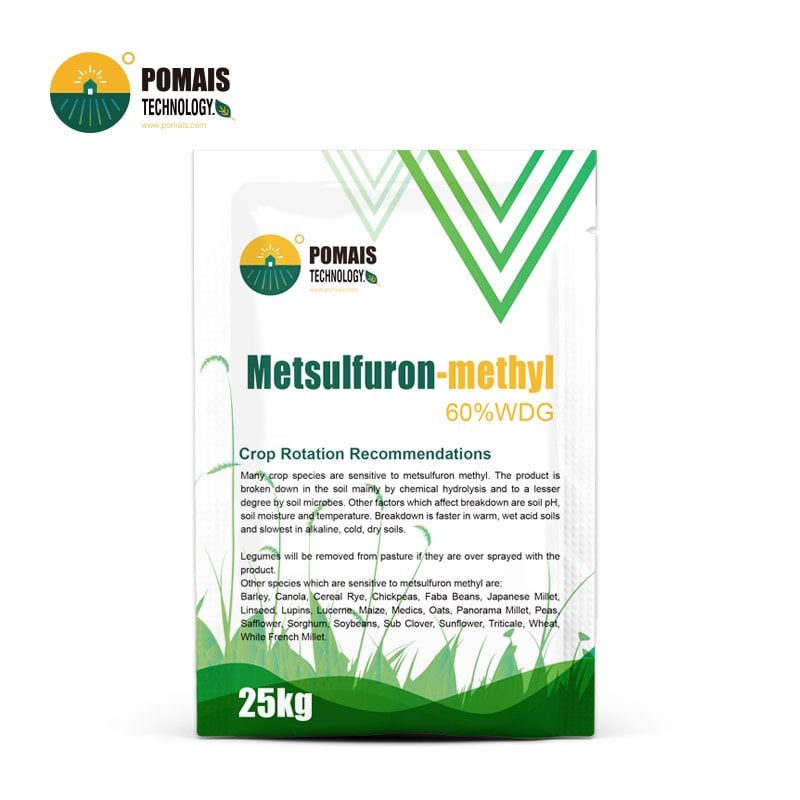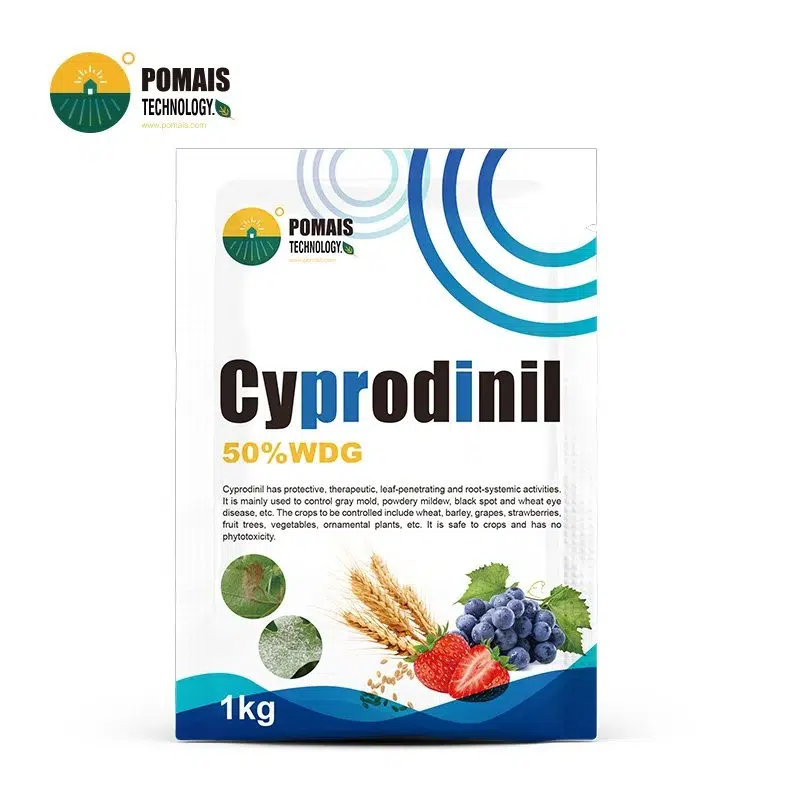Chlorsulfuron 75% DF/WG Herbicide
Selective Weed Control for Wheat and Pastures
If you are looking for a proven sulfonylurea herbicide to manage tough broadleaf weeds and some annual grasses, Chlorsulfuron 75 DF and Chlorsulfuron 75 WG are reliable choices for your growers. Known for its selective systemic activity and residual control, Chlorsulfuron helps protect crops like wheat, barley, oats, and pastures including Tall Fescue, keeping fields clean and productive throughout the season.
At POMAIS, we supply high-quality Chlorsulfuron formulations backed by strict batch consistency, multilingual labeling, OEM private branding, and full registration support to help you serve your local market with confidence.
- Designed for Professional Buyers & Bulk Orders
- This product is available for business purchase and large-scale distribution.
- We support custom packaging, labeling, and formulation to meet your market needs.
- Let’s build your brand together.

About Chlorsulfuron 75% DF/WG Herbicide
About Chlorsulfuron 75% DF/WG Herbicide
| Product Name | Chlorsulfuron 75 DF (Dry Flowable) / 75 WG (Water Dispersible Granule) Herbicide |
| Active Ingredient | Chlorsulfuron (Sulfonylurea herbicide) |
| Content | 75% a.i. |
| CAS Number | 64902-72-3 |
| Chemical Formula | C12H12ClN5O4S |
| Mode of Action | ALS inhibitor – blocks essential branched-chain amino acids; causes stunted growth & weed death |
| Target Weeds | Mustard species, shepherd’s purse, chickweed, sowthistle, wild radish, select annual grasses |
| Target Crops & Areas | Wheat, barley, oats, Tall Fescue, other forage grasses, non-crop areas, industrial sites |
| Recommended Rates | 10–30 g a.i./ha, post-emergence when weeds are at 2–4 leaf stage |
| Formulation Stability | ISO-certified; high solubility; stable in storage; easy tank mixing; consistent field performance |
| Tank Mix Compatibility | Easily tank mixes with 2,4-D, MCPA or other phenoxy herbicides; supports IWM strategies |
| Packaging Options | 100g, 250g, 500g pouches; 1kg–5kg farm packs; 25kg bulk drums for contractors |
| OEM & Private Label | Multilingual labels, custom branding, flexible carton/pallet configuration, full registration dossier support |
| Technical Guidance | Detailed dosage charts, mixing & resistance management, safe use guidelines, local compliance advice |
| Global Standards | ISO 9001 production, batch traceability, GLP/COA/MSDS documentation for all shipments |
| Flexible Supply Chain | Stable production capacity for small orders & bulk exports; suitable for retail and large farm operations |
| Field Scenarios & Training | Ready-to-use field examples, practical usage tips, safe storage and disposal best practices |
Chlorsulfuron 75 DF/WG Herbicide – Selective Weed Control for Wheat and Pastures
Chlorsulfuron is a selective sulfonylurea herbicide developed to provide reliable post-emergence and residual control of a wide range of broadleaf weeds and some annual grasses in cereal crops, forage grasses, and non-crop areas. With its ALS enzyme inhibition mode of action, it stops weed growth at the cellular level by blocking essential amino acid production, leading to growth arrest and eventual weed death.
Your customers benefit from its low-dose, high-activity chemistry, which means lower application rates and less product to handle and store compared to traditional herbicides. This makes Chlorsulfuron 75 DF (dry flowable) and Chlorsulfuron 75 WG (water dispersible granule) convenient and cost-effective options for farmers and contractors managing large acreages.
Our formulations are designed for excellent solubility, easy tank mixing, and consistent field performance under various climate conditions. They work well in integrated weed management (IWM) programs, helping growers rotate or tank mix to delay resistance and protect their crop yields.
From wheat and barley to pastures like Tall Fescue, your buyers can trust Chlorsulfuron herbicide to keep fields clean and competitive season after season.
Mode of Action
Chlorsulfuron herbicide works as a selective systemic ALS (Acetolactate Synthase) inhibitor, blocking the biosynthesis of essential branched-chain amino acids like valine, leucine, and isoleucine within susceptible weeds. This disruption causes cell division to stop, leading to stunted growth, leaf chlorosis, and eventual plant death.
Once applied, Chlorsulfuron 75 DF or Chlorsulfuron 75 WG is quickly absorbed through both leaves and roots, moving throughout the plant’s vascular system. This systemic movement ensures that even underground parts like rootstocks and shoots are affected, which helps prevent regrowth.
Your customers benefit from Chlorsulfuron’s reliable residual activity in the soil. It continues to control germinating weed seedlings for weeks after application, giving crops like wheat, barley, and Tall Fescue a strong competitive advantage during their early growth stages.
This mode of action fits well into integrated weed management (IWM) programs. By rotating Chlorsulfuron herbicide with herbicides that have different modes of action, your buyers help their growers delay resistance development and maintain effective weed control season after season.
Target Crops & Typical Uses
When you provide Chlorsulfuron herbicide, you give your customers a practical tool to control a broad range of annual and some perennial broadleaf weeds, as well as certain annual grasses that compete with valuable crops and pastures.
Primary Target Crops
Cereals: Chlorsulfuron is widely used in wheat, barley, and oats fields for selective post-emergence weed control. Its systemic action keeps fields clean through critical early growth stages, helping protect yield and grain quality.
Pastures & Forage Grasses: Many growers rely on Chlorsulfuron 75 DF or Chlorsulfuron 75 WG to maintain clean stands of Tall Fescue, bromegrass, and mixed forage grasses. Controlling problem broadleaf weeds extends pasture life and improves forage value for livestock.
Non-Crop Areas: In some regions, Chlorsulfuron is registered for use in industrial sites, roadsides, and rights-of-way to suppress invasive broadleaf weeds and maintain clear access.
Typical Target Weeds
Your customers can use Chlorsulfuron to control:
- Mustard species
- Shepherd’s purse
- Chickweed
- Sowthistle
- Wild radish
- Certain annual grasses, depending on local weed spectrum
By helping your buyers match the right crops and weed targets, you position Chlorsulfuron herbicide as a consistent, low-dose solution that works well in integrated weed management programs.
Recommended Dosage & Application
When you guide your buyers on how to apply Chlorsulfuron herbicide correctly, you help them deliver consistent, cost-effective weed control while protecting crops and pastures from unwanted damage.
Chlorsulfuron 75 DF and Chlorsulfuron 75 WG are best applied as a post-emergence spray when target weeds are small and actively growing, typically in the 2 to 4-leaf stage. Good soil moisture and mild temperatures improve herbicide uptake and translocation.
Always remind your customers to:
- Use calibrated sprayers for uniform coverage.
- Avoid spraying under drought stress or extreme temperature fluctuations.
- Follow local rotational crop intervals, as Chlorsulfuron can have soil residual activity.
When tank mixing, especially for broad-spectrum control in cereals or Tall Fescue, recommend a jar test first to ensure physical compatibility with other products.
Example Dosage Guide
| Crop | Target Weeds | Dosage (g a.i./ha) | Application Timing | Application Method |
|---|---|---|---|---|
| Wheat, Barley, Oats | Annual broadleaf weeds | 10–20 | Post-emergence, 2–4 leaf weed stage | Ground foliar spray, uniform cover |
| Pastures (Tall Fescue) | Mustard, Shepherd’s purse, Chickweed | 15–25 | Post-emergence, early weed stage | Ground foliar spray, uniform cover |
| Non-Crop Areas | Invasive broadleaf weeds | 20–30 | As needed, based on local conditions | Spot or broadcast treatment |
Practical Tips:
- Avoid overspray onto sensitive neighboring crops.
- Observe any grazing restrictions for treated pastures.
- Clean spray tanks thoroughly to prevent carryover damage.
By providing clear dosage and application instructions, you show your buyers how to get maximum results from Chlorsulfuron herbicide safely and effectively.
Benefits & Grower Value
When you supply Chlorsulfuron herbicide, you help your customers secure reliable, cost-effective broadleaf weed control that makes a real difference in crop and pasture performance.
High Activity at Low Rates
Thanks to its potent ALS-inhibiting mode of action, Chlorsulfuron 75 DF and Chlorsulfuron 75 WG deliver excellent weed suppression with relatively low application rates. This reduces storage, handling, and transport costs for growers, and allows for easy integration into existing spray programs.
Residual Control with Fewer Repeats
Your buyers gain the advantage of Chlorsulfuron’s residual soil activity, which keeps working after application to control new flushes of sensitive weeds. This means fewer follow-up sprays, saving labor and fuel costs while helping protect crop yield and quality.
Flexible for Different Uses
From wheat and barley fields to Tall Fescue pastures and non-crop areas, Chlorsulfuron herbicide adapts easily to diverse farming systems. It tank mixes well with other herbicides for an expanded weed spectrum, fitting perfectly into integrated weed management (IWM) plans that help delay resistance.
Added Value for Distributors
As your trusted supplier, we deliver strict batch consistency, flexible pack sizes, and multilingual private labeling options. This helps you serve small farms and large contractors alike, strengthening your position as a reliable partner in your market.
By promoting Chlorsulfuron herbicide, you help your customers protect their investment, improve yields, and run more efficient, profitable operations season after season.
Formulation Stability & Packaging Options
When you choose Chlorsulfuron herbicide from POMAIS, you get a product designed for dependable performance in diverse storage and field conditions.
Proven Formulation Stability
Our Chlorsulfuron 75 DF (dry flowable) and Chlorsulfuron 75 WG (water dispersible granule) formulations are engineered to stay free-flowing, moisture-resistant, and easy to dissolve in spray tanks. Each batch is produced under ISO-certified processes with strict quality control to ensure consistent particle size, solubility, and active ingredient content.
This means your customers can store and transport Chlorsulfuron herbicide safely in different climates, with no caking, clumping, or loss of efficacy during the shelf life.
Flexible Packaging Options
We offer a wide range of pack sizes to help you serve farms of all scales:
- Small sachets and foil pouches: 100g, 250g, 500g
- Mid-size farm packs: 1 kg, 5 kg
- Bulk drums for large-scale contractors
All packaging is sealed, moisture-resistant, and designed for safe transport from factory to warehouse and onward to the field.
OEM & Private Label Ready
If you want to grow your market share, our team supports you with:
- Custom private labeling in multiple languages
- Flexible carton and pallet configurations
- Full registration dossiers and technical documentation for your local approvals
When you offer a Chlorsulfuron herbicide that combines proven formulation stability with professional packaging and branding, you make it easy for your customers to stock, sell, and apply with total confidence.
Tank Mix Compatibility & Resistance Management
When you supply Chlorsulfuron herbicide, you give your customers more than just a single-use product — you help them fit it into broader integrated weed management (IWM) strategies that maintain weed control effectiveness over time.
Flexible Tank Mixing
Chlorsulfuron 75 DF and Chlorsulfuron 75 WG are designed to tank mix easily with a range of other herbicides, especially in cereals and forage systems. For example, they can be combined with phenoxy herbicides like 2,4-D or MCPA to broaden the spectrum against more stubborn broadleaf weeds.
When your buyers advise growers to tank mix:
- Always remind them to perform a small jar test first to confirm physical compatibility.
- Use recommended label rates for each active ingredient.
- Ensure equipment is properly cleaned to avoid residue carryover.
This flexibility saves time and labor by allowing growers to tackle multiple weed types in a single pass, especially in wheat fields and Tall Fescue pastures.
Sustainable Resistance Management
As an ALS inhibitor, Chlorsulfuron herbicide can select for resistant weed biotypes if overused alone. You can help your buyers add value by guiding them to rotate herbicide groups each season and use tank mixes with different modes of action.
Additional best practices include:
- Targeting weeds when they are small and actively growing.
- Integrating cultural controls such as crop rotation and stubble management.
- Monitoring fields regularly for signs of resistance.
By providing clear tank mix and resistance management advice, you show your customers that your Chlorsulfuron herbicide is not only effective but also supports long-term sustainable farming.
Safety Measures & Environmental Impact
When you offer Chlorsulfuron herbicide, you show your commitment to helping your buyers promote safe handling, responsible application, and compliance with local environmental standards.
Safe Handling & PPE
Your growers and contractors should always wear proper personal protective equipment (PPE) when mixing or applying Chlorsulfuron 75 DF or Chlorsulfuron 75 WG. This includes:
- Chemical-resistant gloves and protective clothing
- Eye protection such as safety goggles
- A suitable mask or respirator when working with large spray volumes or enclosed tanks
After handling, all equipment should be washed thoroughly, and users should wash hands and exposed skin before eating or drinking.
Responsible Application
Because Chlorsulfuron has residual soil activity, your customers should:
- Avoid spray drift onto sensitive crops, gardens, or nearby broadleaf plants.
- Use calibrated equipment for accurate coverage.
- Apply during calm weather to prevent off-target movement.
Remind growers to check local restrictions on buffer zones near waterways or sensitive habitats, as the product may be persistent in soil.
Proper Storage & Disposal
Advise your buyers to store Chlorsulfuron herbicide in its original sealed packaging, in a dry, cool, well-ventilated space, away from children or animals.
Empty containers should be triple-rinsed and disposed of according to local chemical waste regulations. Leftover spray mixtures should never be dumped near water bodies or drainage systems.
By giving clear safety and environmental guidelines, you help your customers build trust with farmers and local regulators — showing that your Chlorsulfuron 75 DF and Chlorsulfuron 75 WG are used responsibly and sustainably.
Field Use Scenarios
When you share practical examples of Chlorsulfuron herbicide in action, you make it easier for your buyers to see how this product fits into real-world weed management plans and delivers consistent results.
Scenario 1: Post-Emergence Control in Wheat
A grower faces heavy pressure from mustards and shepherd’s purse in a winter wheat field. They apply Chlorsulfuron 75 DF at 15 grams active ingredient per hectare when weeds are in the 2 to 4-leaf stage.
Result: The ALS-inhibiting mode of action stops weed growth quickly. Residual activity keeps the field clean, minimizing follow-up sprays.
Scenario 2: Maintaining Clean Tall Fescue Pastures
A pasture manager wants to maintain clean stands of Tall Fescue for grazing cattle. They use Chlorsulfuron 75 WG at a slightly higher rate to target broadleaf weeds like chickweed and wild radish early in the season.
Result: Pasture health improves, forage quality increases, and livestock get more usable grazing days.
Scenario 3: Tank Mix for Broader Spectrum
In a barley field with mixed broadleaf weeds and some annual grasses, the distributor advises a tank mix of Chlorsulfuron 75 DF plus a phenoxy herbicide like 2,4-D.
Result: The combination provides both quick knockdown and longer-lasting residual control, saving the grower a second application pass.
Scenario 4: Roadside & Non-Crop Maintenance
A municipal contractor uses Chlorsulfuron herbicide on roadsides and non-crop areas to suppress persistent problem weeds. Spot treatments reduce invasive broadleaf pressure while protecting desired grass cover.
Result: Maintenance costs drop, and the area remains accessible and clear for longer.
By giving your buyers these field-tested scenarios, you help them explain to growers and contractors why Chlorsulfuron 75 DF and Chlorsulfuron 75 WG are practical, reliable options for integrated weed management in diverse conditions.
FAQ – Common Questions
Q1: What is Chlorsulfuron herbicide used for?
You can use Chlorsulfuron herbicide for selective control of annual broadleaf weeds and some annual grasses in cereal crops like wheat, barley, and oats, as well as forage grasses like Tall Fescue and certain non-crop areas.
Q2: What is the difference between Chlorsulfuron 75 DF and 75 WG?
Both forms deliver the same active ingredient and mode of action. The main difference is the formulation: 75 DF is dry flowable, while 75 WG is a water dispersible granule. Both dissolve well in tank mixes and are easy to apply with ground equipment.
Q3: How does Chlorsulfuron work?
Chlorsulfuron herbicide works as an ALS inhibitor, blocking essential amino acid synthesis in weeds. This stops growth, causes leaf yellowing, and leads to complete dieback. It also provides soil residual control to prevent new weed flushes.
Q4: Can I use Chlorsulfuron on Tall Fescue pastures?
Yes. Many forage producers use Chlorsulfuron 75 DF or 75 WG to maintain clean stands of Tall Fescue by targeting problem broadleaf weeds. Always follow local label guidelines and observe any grazing intervals.
Q5: Is it safe to tank mix Chlorsulfuron with other herbicides?
Yes. It is commonly tank mixed with herbicides like 2,4-D or MCPA to broaden weed control. Always do a jar test to check compatibility and use recommended label rates.
Q6: What PPE is needed when using Chlorsulfuron?
Growers should wear chemical-resistant gloves, protective clothing, eye protection, and a mask or respirator when handling large volumes or enclosed tanks.
Q7: How do I get Chlorsulfuron herbicide pricing or request a sample?
Contact our team anytime to get the latest price list, request free samples for local performance testing, or discuss custom packaging and OEM labeling options for your market.
Why Choose POMAIS
When you choose POMAIS for your Chlorsulfuron herbicide, you get more than just a proven active ingredient — you secure a reliable partner who helps you build trust and deliver consistent weed control results to your customers.
Our Chlorsulfuron 75 DF and Chlorsulfuron 75 WG formulations are manufactured under strict ISO-certified quality standards, with full batch traceability to ensure every shipment meets your performance expectations. We know your buyers depend on consistent solubility, clean tank mixes, and a stable residual effect to keep their fields weed-free.
Whether you need flexible pack sizes, multilingual private labeling, or registration support for your local market, we provide complete OEM solutions to help you adapt quickly to changing regulations and customer demands.
If you are looking to expand your portfolio with a selective sulfonylurea herbicide that works for wheat, barley, oats, Tall Fescue, and non-crop areas, talk to our team today. Request your customized price list, ask for free samples, or get full technical documentation for your next bulk order.
Let’s help you bring reliable, selective weed control to more growers — season after season.
| Product Name | Chlorsulfuron 75 DF (Dry Flowable) / 75 WG (Water Dispersible Granule) Herbicide |
| Active Ingredient | Chlorsulfuron (Sulfonylurea herbicide) |
| Content | 75% a.i. |
| CAS Number | 64902-72-3 |
| Chemical Formula | C12H12ClN5O4S |
| Mode of Action | ALS inhibitor – blocks essential branched-chain amino acids; causes stunted growth & weed death |
| Target Weeds | Mustard species, shepherd’s purse, chickweed, sowthistle, wild radish, select annual grasses |
| Target Crops & Areas | Wheat, barley, oats, Tall Fescue, other forage grasses, non-crop areas, industrial sites |
| Recommended Rates | 10–30 g a.i./ha, post-emergence when weeds are at 2–4 leaf stage |
| Formulation Stability | ISO-certified; high solubility; stable in storage; easy tank mixing; consistent field performance |
| Tank Mix Compatibility | Easily tank mixes with 2,4-D, MCPA or other phenoxy herbicides; supports IWM strategies |
| Packaging Options | 100g, 250g, 500g pouches; 1kg–5kg farm packs; 25kg bulk drums for contractors |
| OEM & Private Label | Multilingual labels, custom branding, flexible carton/pallet configuration, full registration dossier support |
| Technical Guidance | Detailed dosage charts, mixing & resistance management, safe use guidelines, local compliance advice |
| Global Standards | ISO 9001 production, batch traceability, GLP/COA/MSDS documentation for all shipments |
| Flexible Supply Chain | Stable production capacity for small orders & bulk exports; suitable for retail and large farm operations |
| Field Scenarios & Training | Ready-to-use field examples, practical usage tips, safe storage and disposal best practices |
Chlorsulfuron 75 DF/WG Herbicide – Selective Weed Control for Wheat and Pastures
Chlorsulfuron is a selective sulfonylurea herbicide developed to provide reliable post-emergence and residual control of a wide range of broadleaf weeds and some annual grasses in cereal crops, forage grasses, and non-crop areas. With its ALS enzyme inhibition mode of action, it stops weed growth at the cellular level by blocking essential amino acid production, leading to growth arrest and eventual weed death.
Your customers benefit from its low-dose, high-activity chemistry, which means lower application rates and less product to handle and store compared to traditional herbicides. This makes Chlorsulfuron 75 DF (dry flowable) and Chlorsulfuron 75 WG (water dispersible granule) convenient and cost-effective options for farmers and contractors managing large acreages.
Our formulations are designed for excellent solubility, easy tank mixing, and consistent field performance under various climate conditions. They work well in integrated weed management (IWM) programs, helping growers rotate or tank mix to delay resistance and protect their crop yields.
From wheat and barley to pastures like Tall Fescue, your buyers can trust Chlorsulfuron herbicide to keep fields clean and competitive season after season.
Mode of Action
Chlorsulfuron herbicide works as a selective systemic ALS (Acetolactate Synthase) inhibitor, blocking the biosynthesis of essential branched-chain amino acids like valine, leucine, and isoleucine within susceptible weeds. This disruption causes cell division to stop, leading to stunted growth, leaf chlorosis, and eventual plant death.
Once applied, Chlorsulfuron 75 DF or Chlorsulfuron 75 WG is quickly absorbed through both leaves and roots, moving throughout the plant’s vascular system. This systemic movement ensures that even underground parts like rootstocks and shoots are affected, which helps prevent regrowth.
Your customers benefit from Chlorsulfuron’s reliable residual activity in the soil. It continues to control germinating weed seedlings for weeks after application, giving crops like wheat, barley, and Tall Fescue a strong competitive advantage during their early growth stages.
This mode of action fits well into integrated weed management (IWM) programs. By rotating Chlorsulfuron herbicide with herbicides that have different modes of action, your buyers help their growers delay resistance development and maintain effective weed control season after season.
Target Crops & Typical Uses
When you provide Chlorsulfuron herbicide, you give your customers a practical tool to control a broad range of annual and some perennial broadleaf weeds, as well as certain annual grasses that compete with valuable crops and pastures.
Primary Target Crops
Cereals: Chlorsulfuron is widely used in wheat, barley, and oats fields for selective post-emergence weed control. Its systemic action keeps fields clean through critical early growth stages, helping protect yield and grain quality.
Pastures & Forage Grasses: Many growers rely on Chlorsulfuron 75 DF or Chlorsulfuron 75 WG to maintain clean stands of Tall Fescue, bromegrass, and mixed forage grasses. Controlling problem broadleaf weeds extends pasture life and improves forage value for livestock.
Non-Crop Areas: In some regions, Chlorsulfuron is registered for use in industrial sites, roadsides, and rights-of-way to suppress invasive broadleaf weeds and maintain clear access.
Typical Target Weeds
Your customers can use Chlorsulfuron to control:
- Mustard species
- Shepherd’s purse
- Chickweed
- Sowthistle
- Wild radish
- Certain annual grasses, depending on local weed spectrum
By helping your buyers match the right crops and weed targets, you position Chlorsulfuron herbicide as a consistent, low-dose solution that works well in integrated weed management programs.
Recommended Dosage & Application
When you guide your buyers on how to apply Chlorsulfuron herbicide correctly, you help them deliver consistent, cost-effective weed control while protecting crops and pastures from unwanted damage.
Chlorsulfuron 75 DF and Chlorsulfuron 75 WG are best applied as a post-emergence spray when target weeds are small and actively growing, typically in the 2 to 4-leaf stage. Good soil moisture and mild temperatures improve herbicide uptake and translocation.
Always remind your customers to:
- Use calibrated sprayers for uniform coverage.
- Avoid spraying under drought stress or extreme temperature fluctuations.
- Follow local rotational crop intervals, as Chlorsulfuron can have soil residual activity.
When tank mixing, especially for broad-spectrum control in cereals or Tall Fescue, recommend a jar test first to ensure physical compatibility with other products.
Example Dosage Guide
| Crop | Target Weeds | Dosage (g a.i./ha) | Application Timing | Application Method |
|---|---|---|---|---|
| Wheat, Barley, Oats | Annual broadleaf weeds | 10–20 | Post-emergence, 2–4 leaf weed stage | Ground foliar spray, uniform cover |
| Pastures (Tall Fescue) | Mustard, Shepherd’s purse, Chickweed | 15–25 | Post-emergence, early weed stage | Ground foliar spray, uniform cover |
| Non-Crop Areas | Invasive broadleaf weeds | 20–30 | As needed, based on local conditions | Spot or broadcast treatment |
Practical Tips:
- Avoid overspray onto sensitive neighboring crops.
- Observe any grazing restrictions for treated pastures.
- Clean spray tanks thoroughly to prevent carryover damage.
By providing clear dosage and application instructions, you show your buyers how to get maximum results from Chlorsulfuron herbicide safely and effectively.
Benefits & Grower Value
When you supply Chlorsulfuron herbicide, you help your customers secure reliable, cost-effective broadleaf weed control that makes a real difference in crop and pasture performance.
High Activity at Low Rates
Thanks to its potent ALS-inhibiting mode of action, Chlorsulfuron 75 DF and Chlorsulfuron 75 WG deliver excellent weed suppression with relatively low application rates. This reduces storage, handling, and transport costs for growers, and allows for easy integration into existing spray programs.
Residual Control with Fewer Repeats
Your buyers gain the advantage of Chlorsulfuron’s residual soil activity, which keeps working after application to control new flushes of sensitive weeds. This means fewer follow-up sprays, saving labor and fuel costs while helping protect crop yield and quality.
Flexible for Different Uses
From wheat and barley fields to Tall Fescue pastures and non-crop areas, Chlorsulfuron herbicide adapts easily to diverse farming systems. It tank mixes well with other herbicides for an expanded weed spectrum, fitting perfectly into integrated weed management (IWM) plans that help delay resistance.
Added Value for Distributors
As your trusted supplier, we deliver strict batch consistency, flexible pack sizes, and multilingual private labeling options. This helps you serve small farms and large contractors alike, strengthening your position as a reliable partner in your market.
By promoting Chlorsulfuron herbicide, you help your customers protect their investment, improve yields, and run more efficient, profitable operations season after season.
Formulation Stability & Packaging Options
When you choose Chlorsulfuron herbicide from POMAIS, you get a product designed for dependable performance in diverse storage and field conditions.
Proven Formulation Stability
Our Chlorsulfuron 75 DF (dry flowable) and Chlorsulfuron 75 WG (water dispersible granule) formulations are engineered to stay free-flowing, moisture-resistant, and easy to dissolve in spray tanks. Each batch is produced under ISO-certified processes with strict quality control to ensure consistent particle size, solubility, and active ingredient content.
This means your customers can store and transport Chlorsulfuron herbicide safely in different climates, with no caking, clumping, or loss of efficacy during the shelf life.
Flexible Packaging Options
We offer a wide range of pack sizes to help you serve farms of all scales:
- Small sachets and foil pouches: 100g, 250g, 500g
- Mid-size farm packs: 1 kg, 5 kg
- Bulk drums for large-scale contractors
All packaging is sealed, moisture-resistant, and designed for safe transport from factory to warehouse and onward to the field.
OEM & Private Label Ready
If you want to grow your market share, our team supports you with:
- Custom private labeling in multiple languages
- Flexible carton and pallet configurations
- Full registration dossiers and technical documentation for your local approvals
When you offer a Chlorsulfuron herbicide that combines proven formulation stability with professional packaging and branding, you make it easy for your customers to stock, sell, and apply with total confidence.
Tank Mix Compatibility & Resistance Management
When you supply Chlorsulfuron herbicide, you give your customers more than just a single-use product — you help them fit it into broader integrated weed management (IWM) strategies that maintain weed control effectiveness over time.
Flexible Tank Mixing
Chlorsulfuron 75 DF and Chlorsulfuron 75 WG are designed to tank mix easily with a range of other herbicides, especially in cereals and forage systems. For example, they can be combined with phenoxy herbicides like 2,4-D or MCPA to broaden the spectrum against more stubborn broadleaf weeds.
When your buyers advise growers to tank mix:
- Always remind them to perform a small jar test first to confirm physical compatibility.
- Use recommended label rates for each active ingredient.
- Ensure equipment is properly cleaned to avoid residue carryover.
This flexibility saves time and labor by allowing growers to tackle multiple weed types in a single pass, especially in wheat fields and Tall Fescue pastures.
Sustainable Resistance Management
As an ALS inhibitor, Chlorsulfuron herbicide can select for resistant weed biotypes if overused alone. You can help your buyers add value by guiding them to rotate herbicide groups each season and use tank mixes with different modes of action.
Additional best practices include:
- Targeting weeds when they are small and actively growing.
- Integrating cultural controls such as crop rotation and stubble management.
- Monitoring fields regularly for signs of resistance.
By providing clear tank mix and resistance management advice, you show your customers that your Chlorsulfuron herbicide is not only effective but also supports long-term sustainable farming.
Safety Measures & Environmental Impact
When you offer Chlorsulfuron herbicide, you show your commitment to helping your buyers promote safe handling, responsible application, and compliance with local environmental standards.
Safe Handling & PPE
Your growers and contractors should always wear proper personal protective equipment (PPE) when mixing or applying Chlorsulfuron 75 DF or Chlorsulfuron 75 WG. This includes:
- Chemical-resistant gloves and protective clothing
- Eye protection such as safety goggles
- A suitable mask or respirator when working with large spray volumes or enclosed tanks
After handling, all equipment should be washed thoroughly, and users should wash hands and exposed skin before eating or drinking.
Responsible Application
Because Chlorsulfuron has residual soil activity, your customers should:
- Avoid spray drift onto sensitive crops, gardens, or nearby broadleaf plants.
- Use calibrated equipment for accurate coverage.
- Apply during calm weather to prevent off-target movement.
Remind growers to check local restrictions on buffer zones near waterways or sensitive habitats, as the product may be persistent in soil.
Proper Storage & Disposal
Advise your buyers to store Chlorsulfuron herbicide in its original sealed packaging, in a dry, cool, well-ventilated space, away from children or animals.
Empty containers should be triple-rinsed and disposed of according to local chemical waste regulations. Leftover spray mixtures should never be dumped near water bodies or drainage systems.
By giving clear safety and environmental guidelines, you help your customers build trust with farmers and local regulators — showing that your Chlorsulfuron 75 DF and Chlorsulfuron 75 WG are used responsibly and sustainably.
Field Use Scenarios
When you share practical examples of Chlorsulfuron herbicide in action, you make it easier for your buyers to see how this product fits into real-world weed management plans and delivers consistent results.
Scenario 1: Post-Emergence Control in Wheat
A grower faces heavy pressure from mustards and shepherd’s purse in a winter wheat field. They apply Chlorsulfuron 75 DF at 15 grams active ingredient per hectare when weeds are in the 2 to 4-leaf stage.
Result: The ALS-inhibiting mode of action stops weed growth quickly. Residual activity keeps the field clean, minimizing follow-up sprays.
Scenario 2: Maintaining Clean Tall Fescue Pastures
A pasture manager wants to maintain clean stands of Tall Fescue for grazing cattle. They use Chlorsulfuron 75 WG at a slightly higher rate to target broadleaf weeds like chickweed and wild radish early in the season.
Result: Pasture health improves, forage quality increases, and livestock get more usable grazing days.
Scenario 3: Tank Mix for Broader Spectrum
In a barley field with mixed broadleaf weeds and some annual grasses, the distributor advises a tank mix of Chlorsulfuron 75 DF plus a phenoxy herbicide like 2,4-D.
Result: The combination provides both quick knockdown and longer-lasting residual control, saving the grower a second application pass.
Scenario 4: Roadside & Non-Crop Maintenance
A municipal contractor uses Chlorsulfuron herbicide on roadsides and non-crop areas to suppress persistent problem weeds. Spot treatments reduce invasive broadleaf pressure while protecting desired grass cover.
Result: Maintenance costs drop, and the area remains accessible and clear for longer.
By giving your buyers these field-tested scenarios, you help them explain to growers and contractors why Chlorsulfuron 75 DF and Chlorsulfuron 75 WG are practical, reliable options for integrated weed management in diverse conditions.
FAQ – Common Questions
Q1: What is Chlorsulfuron herbicide used for?
You can use Chlorsulfuron herbicide for selective control of annual broadleaf weeds and some annual grasses in cereal crops like wheat, barley, and oats, as well as forage grasses like Tall Fescue and certain non-crop areas.
Q2: What is the difference between Chlorsulfuron 75 DF and 75 WG?
Both forms deliver the same active ingredient and mode of action. The main difference is the formulation: 75 DF is dry flowable, while 75 WG is a water dispersible granule. Both dissolve well in tank mixes and are easy to apply with ground equipment.
Q3: How does Chlorsulfuron work?
Chlorsulfuron herbicide works as an ALS inhibitor, blocking essential amino acid synthesis in weeds. This stops growth, causes leaf yellowing, and leads to complete dieback. It also provides soil residual control to prevent new weed flushes.
Q4: Can I use Chlorsulfuron on Tall Fescue pastures?
Yes. Many forage producers use Chlorsulfuron 75 DF or 75 WG to maintain clean stands of Tall Fescue by targeting problem broadleaf weeds. Always follow local label guidelines and observe any grazing intervals.
Q5: Is it safe to tank mix Chlorsulfuron with other herbicides?
Yes. It is commonly tank mixed with herbicides like 2,4-D or MCPA to broaden weed control. Always do a jar test to check compatibility and use recommended label rates.
Q6: What PPE is needed when using Chlorsulfuron?
Growers should wear chemical-resistant gloves, protective clothing, eye protection, and a mask or respirator when handling large volumes or enclosed tanks.
Q7: How do I get Chlorsulfuron herbicide pricing or request a sample?
Contact our team anytime to get the latest price list, request free samples for local performance testing, or discuss custom packaging and OEM labeling options for your market.
Why Choose POMAIS
When you choose POMAIS for your Chlorsulfuron herbicide, you get more than just a proven active ingredient — you secure a reliable partner who helps you build trust and deliver consistent weed control results to your customers.
Our Chlorsulfuron 75 DF and Chlorsulfuron 75 WG formulations are manufactured under strict ISO-certified quality standards, with full batch traceability to ensure every shipment meets your performance expectations. We know your buyers depend on consistent solubility, clean tank mixes, and a stable residual effect to keep their fields weed-free.
Whether you need flexible pack sizes, multilingual private labeling, or registration support for your local market, we provide complete OEM solutions to help you adapt quickly to changing regulations and customer demands.
If you are looking to expand your portfolio with a selective sulfonylurea herbicide that works for wheat, barley, oats, Tall Fescue, and non-crop areas, talk to our team today. Request your customized price list, ask for free samples, or get full technical documentation for your next bulk order.
Let’s help you bring reliable, selective weed control to more growers — season after season.
Related Products
Latest News

